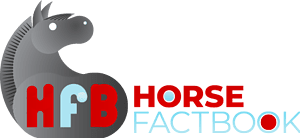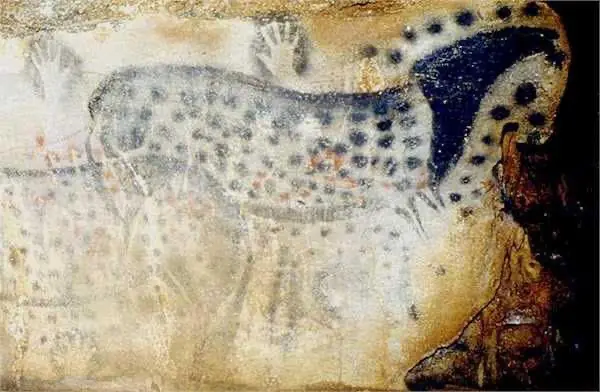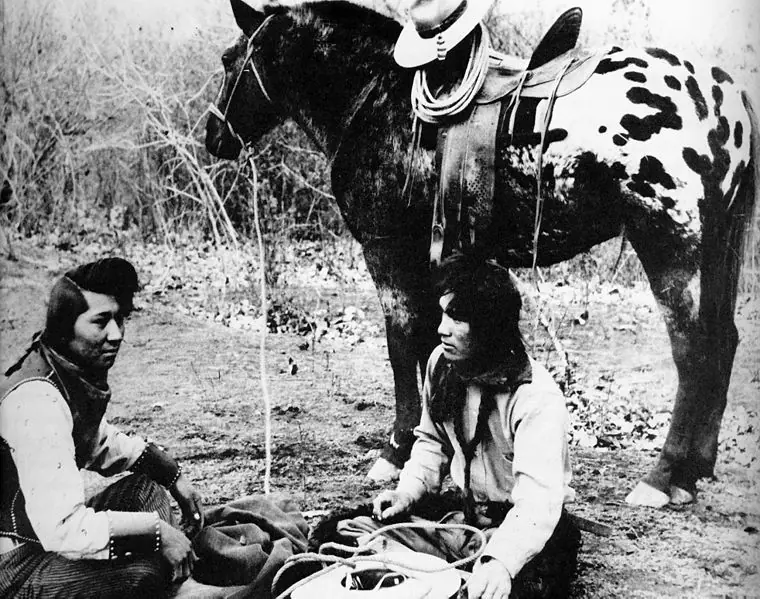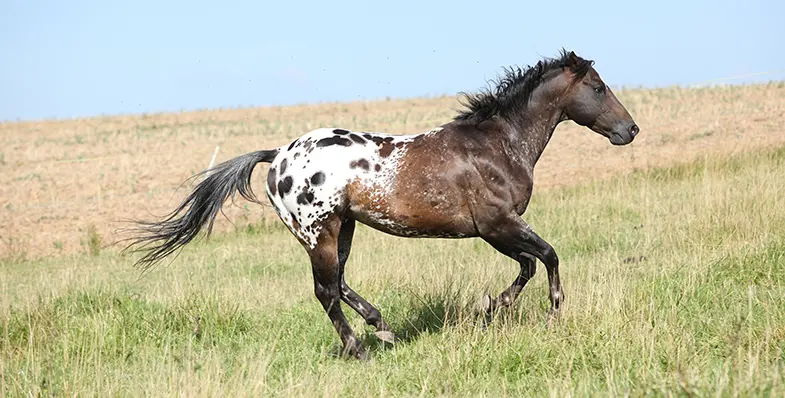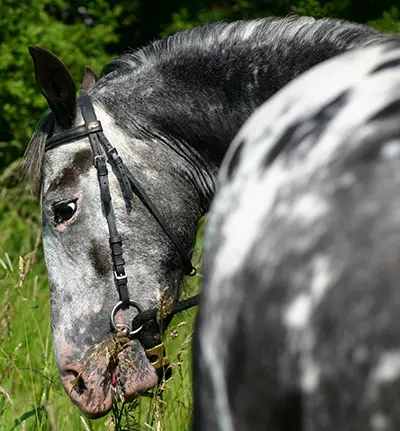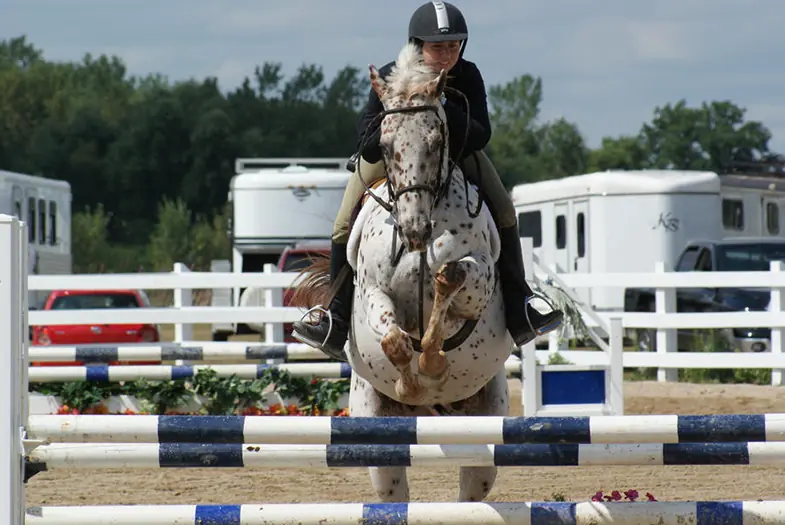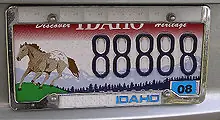With its striking coat pattern, there’s no mistaking the Appaloosa but there’s much more to this eye-catching breed than just their distinctive markings. Often wrongly claimed to be nothing more than a colored horse and not a true breed, the Appaloosa is much more than just a color. Read on to find out just how incredible these horses are.
Height: Typically Appaloosas stand between 14hh (56 inches) and 15hh (60 inches) although they can reach 16hh (64 inches).
Color: Any solid colored base coat with spots.
Personality: Appaloosas have kind, gentle temperaments and are known for their affection. They’re also very intelligent horses that are eager to learn and to please.
Country of Origin: USA
Registry: Appaloosa Horse Club
An Asian (rather than Spanish) beginning
For many years it was thought that the Appaloosa was a direct descendant of the Spanish horses that arrived in America with the conquistadors and subsequent settlers but recent studies have cast doubt on this theory. There’s no doubt that Spanish horses did play a role in the breed’s development but just not as important a role as first thought. After all, how many spotted Spanish horses have you seen?
It’s now believed that instead of coming from Southern Europe they made their way (with settlers and traders) through Russia and Asia, across the Bering Strait, and landed on the Pacific Coast instead. Recent DNA testing of spotted wild Mongolian horses has confirmed that they are in fact ancestors of the Appaloosa.
Their spotted coloring is Prehistoric
Many of us never consider where different horse markings come from but while nobody knows exactly when the spotted pattern first appeared we do know that it’s Prehistoric.
You’d be forgiven for thinking that the Appaloosa’s distinctive coat pattern is relatively new but it’s actually one of the oldest coat patterns in history. While ancient artifacts from Greece and China show this colorization was highly prized its Prehistoric man who first brought them to our attention. Ancient cave paintings found in the Lascaux cave complex in southern France have numerous depictions of spotted horses. These paintings have been dated to around 15,000BC, that’s 11,000 years before we first domesticated horses.
Made famous by the Nez Percé Indians
The Nez Percé Indians were expert horsemen and could often ride before they could walk (there are many stories of babies being strapped to horses to keep them in the saddle while they slept) but this wasn’t always the case. Originally a fishing tribe, they first acquired horses in the early 1700s which gave them the opportunity to hunt bison and broaden their hunting grounds.
Unlike a lot of other tribes though the Nez Percé didn’t just trade horses, they bred their own and had an active breeding program designed to develop fast, nimble horses that were surefooted and had plenty of stamina.
While they didn’t specifically breed horses for their spots, the horses they did breed would often have spots. Something Lewis and Clark noticed when they first came across the Nez Percé while they were mapping the western territories (recently purchased in the Louisiana Purchase). They both referred to active and durable horses that were of excellent quality and had large irregular spots in their expedition journal. [source]
Ghost wind stallions
We all like stories and legends and the Nez Percé were no different with the story of the Ghost Wind Stallions is just one such example, although there is some truth behind this legend. Nez Percé folklore tells of three stallions that came out of the sea to create the Appaloosa breed, I know that horses don’t come from the sea but there is always some truth behind every tale and this one is no exception.
It’s known that the Nez Percé would regularly trade with sailors who used the Bering Strait to bring horses (and other goods) from Russia and Asia which is where this story begins. Once the Nez Percé had these horses they began selecting those with superior quality for breeding.
While many horses had the qualities they desired and were suitable for breeding, three stallions were of such an outstanding caliber that they became legendary and were collectively known as the Ghost Wind Stallions. Sadly after the infamous Nez Percé War only one horse, Winged Hawk was left but the legacy of all three is present in the breed today. Every horse that can trace its pedigree back to one of those three stallions can also be registered as a Foundation Appaloosa.
Known by many other names
Originally bred along the shores of the Palouse River (which runs through Washington and Idaho) the Appaloosa has been known by a variety of other names such as Palousey, Appalucy (my personal favorite), and Apalouse. In time they became known as ‘a Palouse Horse’ which eventually evolved into the name we know them by today. Many Appaloosa owners and enthusiasts lovingly refer to the breed as Appy’s.
The Appaloosa was almost wiped out
After the Nez Percé War of 1877 the Appaloosa breed was completely decimated (the army killed nearly 2000 of these beautiful horses) and the Indians were banned from breeding horses ever again. Luckily though the army hadn’t killed every horses and while some did survive they were dispersed across the US.
With the Nez Percé having been banned from breeding horses you would have thought that it would have spelled the end of the Appaloosa but thanks to the efforts of one man this wasn’t the case. In 1894 an Idahoan rancher named Claude Thompson unwittingly bought one of the original Nez Percé Appaloosa. Recognizing the horse’s quality he began to buy as many of these horses as he could find.
Thanks to his efforts (and those of fellow early enthusiasts such as Dr. Francis Haines and George Hatley) and the establishment o the Appaloosa Horse Club (ApHC), the Appaloosa has gone from strength to strength.
No longer considered a rare breed
While the Appaloosa may have had a very turbulent past its future is looking extremely bright and has done since the Appaloosa Horse Club (ApHC) was established back in 1938. Today there are hundreds of thousands of registered Appaloosas and the ApHC is the third largest breed registry in the world.
Despite the Appaloosa’s popularity, Foundation Appaloosas are still considered rare with there being only around 200 horses in the world.
There’s a variety of coat patterns
An Appaloosa’s spots are probably its most identifiable feature but there are a variety of different coat patterns they can have.
| Pattern | Description | Changes | Base color |
|---|---|---|---|
| Leopard | Dark spots over the entire body, including the head and legs. | No change | Gray |
| Near Leopard | Head and legs have are dark while the rest of the body has dark spots. | Head/legs fade to show more spots | Gray |
| FewSpot Leopard | A few spots over the entire body | Roan coloring can fade | Gray with roan |
| Near FewSpot | Dark head, neck, and legs with a few spots over the rest of the body | No change | Gray |
| Spotted Blanket | Dark colored horse with a white area over the back, rump, and legs that has spots | No change | Any except gray |
| White Blanket / Snowcap | The same as a spotted blanket but with little or no spots | No change | Any except gray |
| Frosted Blanket / Frosted Hip | Dark body with white spots over the hips and loins | No change | Any except gray |
| Snowflake | Dark body with small white spots over the whole body | No change | Any except gray |
| Marble | Red or blue roan with darker spots | Spots can fade as the horse matures | Chestnut, bay, or black |
The leopard complex gene
The Appaloosa’s spotted coat pattern is caused by the presence of a gene known as the leopard complex gene (or LP gene). The gene doesn’t guarantee a horse will have spots but they will always pass it down to its offspring, the more striking a horse’s pattern is the greater the chance of their offspring having spots.
As well as being responsible for a horse’s spots the LP gene also gives the horse a number of other characteristics that allow you easily identify whether or not it’s carrying the gene. These characteristics include:
- Mottled skin – Sometimes called parti colored or marbled skin, it refers to the pink and black mottling over a horse’s body. This is most noticeable around the muzzle, eyes and genital area.
- White sclera – Also called a human eye, the sclera around the horse’s eye (which is dark in other horses) is white and visible in Appaloosas.
- Striped hooves – Not always present in solid colored horses, the hooves are covered with thin, vertical lines or stripes.
Their spots are as unique as our fingerprints
They say that a leopard never changes its spots but they should also say that no two patterns are ever the same and are truly unique to the horse. Unlike our fingerprints though you can actually ‘feel’ an Appaloosa’s spots. This is because the hairs within the spots are often shorter and very slightly softer.
Horses without spots can still be registered
While the Appaloosa is well known for its spots you might be surprised to know that not all horses have spots and can even be registered if they don’t, as long as they have the required characteristics mentioned above.
Solid colored Appaloosas that have these characteristics also have to prove their parentage before being accepted for registration and will have their status marked as NC which stands for ’Non-Characteristic’.
Just because a horse has spots doesn’t mean it’s an Appaloosa
The spotted coat pattern is sometimes referred to as Appaloosa coloring but this doesn’t mean it’s exclusive to the breed. There are a number of other breeds that are known for having spotted markings while others, that aren’t predominantly spotted, will be allowed spotted horses into their registries. These breeds include:
- Knabstrupper
- Nez Percé Horse
- Pony of the Americas
- Colorado Ranger
- British Spotted Pony
- Walkaloosa
- Tiger Horse
- Noriker
- Sugarbush Harlequin
A horse for all reasons
Being one of the most versatile breeds in the world, the Appaloosa has earned the right to be described as a horse for all reasons. Having originally been bred for its versatility, strength, and stamina it retains these same characteristics today.
The Appaloosa can literally turn its hoof to anything and this can be seen at the top of any number of disciplines such as roping, cutting endurance, dressage, jumping, and even racing (both barrel and flat racing).
Their striking coat patterns and Native American history means they’re a popular sight at many parades and historical re-enactments.
Their personality reflects that of their owners
Appaloosas sometimes have a bad reputation for being stubborn and bolshie but this isn’t true. They’re extremely kind, gentle, and loyal horses that would do anything for their owners.
While they are very loyal and affectionate horses you do have to earn their trust which is why some people call them bad-tempered. If you treat an Appaloosa with kindness and respect it will love you for life. On the other hand though, if you mistreat them they will reflect this and won’t listen to you or respect your authority.
Prone to eye disease
While the LP gene is known to give the Appaloosa its beautiful markings it does have a downside in that horses carrying the gene are prone to certain eye conditions that can result in blindness.
- Equine recurrent uveitis (ERU) – Also known as moon blindness, ERU is a common disease that is the leading cause of blindness in horses and those carrying the LP gene are 8 times more likely to suffer from it.
- Congenital stationary night blindness – Not as serious as ERU, this can reduce a horse’s ability to see in darkness or very low light (such as at dawn or dusk).
Official state horse of Idaho
In 1975 Governor Cecil Andrus named the Appaloosa as the official the state horse of Idaho in recognition of its association with the Nez Percé Indians. To mark this the state also introduced a custom license plate that shows its connection with the breed.
As well as being the state’s official horse, the Appaloosa is also the state fossil, although this is more of a loose connection as many people rightly say the fossil is just the horse.
Famous Appaloosas and owners
Over the years there have been a number of famous Appaloosas as well as some equally famous owners.
Famous horses
Endo The Blind, who is also known as Endo The Incredible, is a blind Appaloosa that has become a YouTube star.
Since 1978 Florida State University has signaled the start of every home game with a horse being ridden down the center of the field throwing spears. Ever since the tradition began they’ve used an Appaloosa called Renegade, with six different horses playing his role over the years.
One of the most famous horses in Hollywood has to be the stunning horse John Wayne rode in El Dorado. The beautiful stallion, who would also perform tricks, was an Appaloosa known as Zip Cochise
Famous owners
Since his first encounter with the breed in the 1970s, Richard Gere has become a very vocal fan of the breed, having admitted to owning 27 at once.
By far the most famous Appaloosa owner has to be Sir Paul McCartney who is known to have a handful of Foundation Appaloosas including his favorite, MoonStar. [source]
Other famous owners include country star Loretta Lynn and Hollywood legend Burt Reynolds.
Related questions
Are Appaloosas good for beginners?
Thanks to their kind temperaments and sensible natures Appaloosas are ideal for new or nervous riders and are often a popular choice for first-time owners. They have a real sense of responsibility and are willing to look after any rider they have. They’re all loving horses that have a real desire to please.
How much do Appaloosas cost?
The Appaloosas is an extremely popular breed which means that you can easily buy a registered horse for around $1000 but this price can increase quite considerably depending on the horse’s age, training and pedigree. With this in mind, it’s not uncommon for a good quality, well-trained Appaloosa with a strong pedigree selling for well over $10,000.
Further reading
- Dotty about spotties!
- The top 11 trail riding horses
- The world’s rarest horses
- The fastest barrel racers
- The friendliest horse breeds
- The most expensive breeds
- The world’s cheapest breeds
- The most unusual horse breeds
I hope you found this article helpful. If you did I’d be grateful if you could share it please as it would really help me.
Recommended products
Over the years I have tried hundreds of different horsey products, from various blankets and halters to different treats. Some I’ve loved, others I’ve hated but I thought I’d share with you my top all-time favorite products, the ones I never leave the yard without. I’ve included links to the products (which are in no particular order) that I really think are great.
- Horse Knots by Reference Ready – If you’re like me and enjoy pocket reference guides then you’ll love this knot tying guide. These handy cards can easily fit in your pocket or attach to the saddle for quick reference. They’re waterproof, durable and are color coded to make them easy to follow.
- Mane ’n Tail Detangler – Even if you never show your horse you’ll need to detangle his tail from time to time (and possibly his mane too) which is always a challenging chore! I’ve found that if I run a little bit of detangler through my horse’s tails every few days it stops them from getting matted up and makes combing them easy, even if they’re coated in mud. I don’t know if I should admit to this or not but it also works wonders on my hair.
- TAKEKIT Pro clippers – Over the years I’ve tried a lot of different clippers and while some were obviously better than others I found these to be by far the best. They are heavier than a lot of other clippers but for me, that’s a good thing, it makes them feel more sturdy and hardwearing. On top of that they have a range of speeds so are just as good for clipping your horse’s back as they are his face. I also like the fact that they come in a handy carry case but that’s not for everybody. The company that makes them is super good and incredibly helpful too, a real bonus these days. The only thing I wasn’t keen on was the fact that it doesn’t come with any oil, but that’s not a major problem as it’s not difficult to buy lubricant.
- Shire’s ball feeder – There are so many boredom buster toys out there but I like to use these every day, regardless of whether or not my horses are bored. I find that it helps to encourage my horses to problem solve by rewarding them with treats (or pieces of fruit) but it also mimics their natural grazing behavior which helps to keep them calm and de-stressed.
- Horse safe mirror – This is a strange one that many people are surprised about but I like to put horse safe mirrors in the trailers as well as in the quarantine stalls. It helps to prevent the feeling of isolation by giving the impression of other horses being around. Being herd animals horses can get extremely stressed when they feel that they’re on their own but with these stick-on mirrors, they believe that at least one other horse is with them.
- Rectal thermometer – I know this isn’t glamourous at all but it’s vital for your horse’s well-being to be able to check their temperature and a rectal thermometer is the easiest way of doing this which is why I’ve added it to the list.
Shopping lists
I’ve also put together a few shopping lists of essential items that I’ve found helpful over the years. I’ve broken the lists down into different categories rather than put everything in one massive list 😉
Recent Posts
Pads & Blankets: What Are They And Are They Really Necessary?
When we think about what tack we need, saddle pads and saddle blankets aren’t often at the forefront of our minds. We all know that they go underneath a saddle but there’s still a lot of...
Have you ever wondered what racehorses wear over their eyes, or seen a horse pulling a carriage with its eyes covered? Known as blinders or blinkers, these strange coverings do actually serve a...
